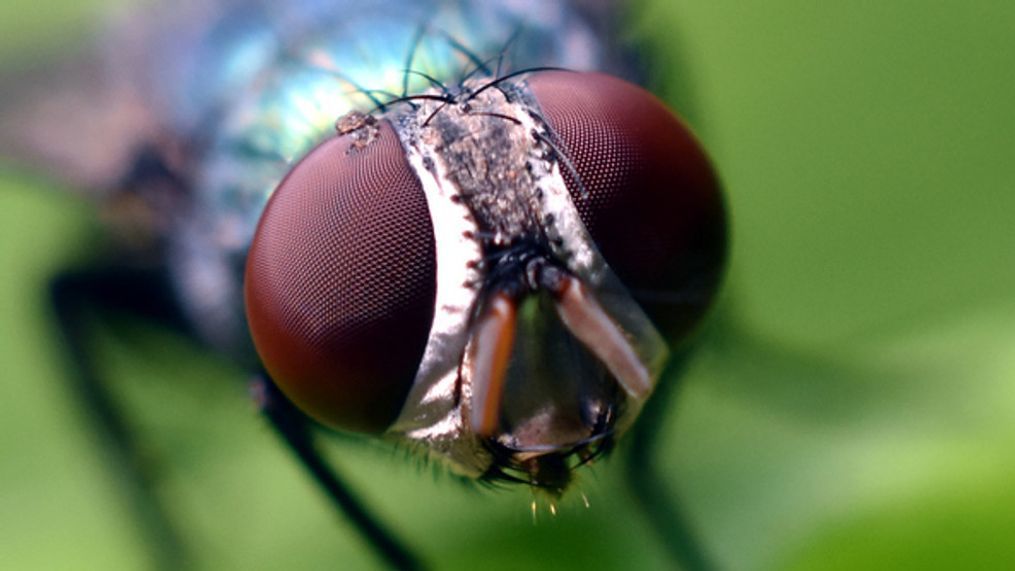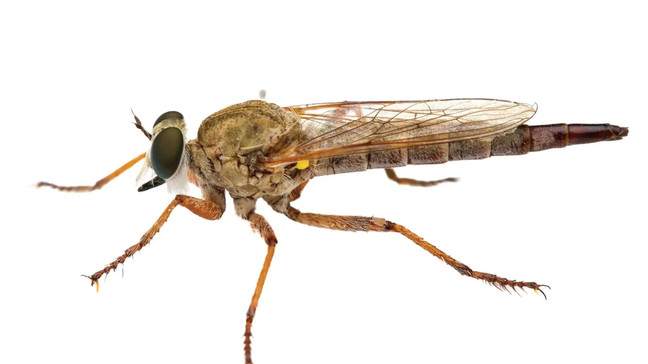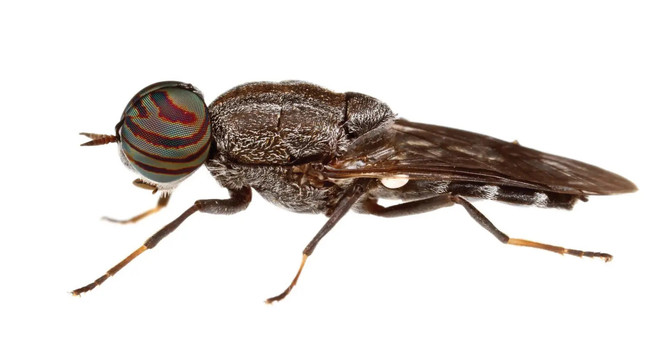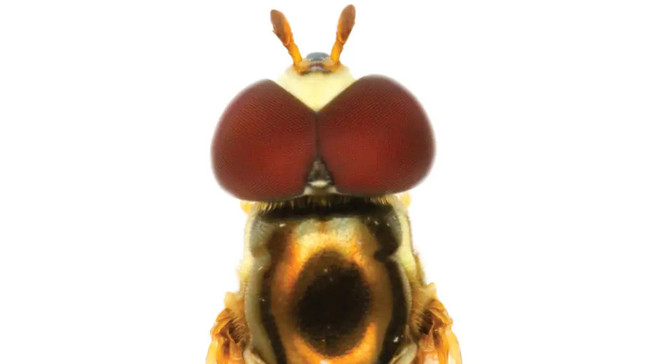Meet the flies of Texas
ONE SUMMER DAY SEVERAL YEARS AGO, we noticed a large black wasp hanging out on some rocks in our backyard. More than an inch long, the insect had bulging eyes and an orange band around its middle. A few afternoons later, two more showed up. I watched as the trio tussled beneath a potted plant. Finally, one pair coupled and flew away, leaving the third barely moving on a rock
“I’ve never seen that kind of wasp before,” I told my husband while I snapped photos. “They look scary.”
Imagine my surprise when I learned that my big black wasp was not a wasp but a FLY. Count me among many who’ve mistaken a clubbed mydas fly for a wasp. Despite their fierce appearance, mydas flies have no stinger and can’t bite. Adults nectar on flowers; larvae likely eat beetle grubs.
Sweet, not scary.
Once upon a time, the word “fly” to me meant pesky house flies and fruit flies. Not anymore.
As I began to document wildlife species in our Blanco yard, the diversity of flies astounded me. Who knew that some mimic wasps, bees and even moths? That others dive-bomb their meals or sport mesmerizing eyes? That some aren’t even well known as flies?
Not me! That is, until I started learning more about flies.
Flies rank among the four largest groups of insects, which include the order Coleoptera (beetles), Hymenoptera (ants, bees and wasps) and Lepidoptera (butterflies and moths). Around the world, biologists have described more than 158,000 fly species. In the United States, some 17,000 to 19,600 species have been documented. In Texas, we have approximately 5,100 species. If you want to explore the world of flies in your own yard, snap some photos and enter them on iNaturalist for identification help and fun facts.
In Blanco, I’ve observed an amazing 115 species on our just-under-an-acre property, brimming with native plants.
WHAT’S A FLY?
AS I’VE EXPERIENCED, some flies can be mistaken for wasps or bees, which have two pairs of wings. True flies have only one pair of wings and belong to the order Diptera, a name coined from the Greek words di (two) and ptera (wings). Instead of hindwings, flies have a pair of lollipop-shaped halteres, sensory organs that enable them to hover and maneuver quickly in flight.
Fly faces feature large compound eyes and a variety of sucking or sponging mouthparts. For some flies, sex can be determined by the eyes. Males have eyes that connect; females have a gap between theirs.
As a side note, entomologist Roy Parker (retired from the Texas A&M AgriLife Extension Service) points out that, unlike other species, when the common names of true flies include the term “fly,” the words are always separated by a space: house fly, deer fly and crane fly.
“In other insect orders, common names may include the word ‘fly,’ too,” he says. “In that case, then the word is one. Some examples are dragonfly, damselfly, stonefly, mayfly, dobsonfly, owlfly, butterfly and scorpionfly.”
Altogether, flies “arguably have more impact on man than any other insect order,” write John and Kendra Abbott in Common Insects of Texas and Surrounding States. “This is because a number of species, particularly those with aquatic larvae, are major vectors of disease.”
Most notable are mosquitos, touted as one of the world’s deadliest animals. Every year, they sicken and kill thousands of people by transmitting diseases such as yellow fever, dengue, encephalitis and malaria.
Whoa, back up. Mosquitos are flies?
That was news to me. So are gnats and no-see-ums (those awful, biting midges).
“Love bugs,” too. In East Texas, the black-bodied love bugs with reddish humpbacks swarm in the spring and fall, creating a nightmare for drivers. Their splattered remains make cleaning windshields and front grills a gruesome task. Other kinds of flies attack crops, orchards and animals.
Flies aren’t total villains. On the beneficial side, many flies pollinate flowers. They also help in controlling other insects and are part of nature’s food chain. As decomposers, some flies that breed in carrion (dead animals) — namely blow flies — help in solving crimes.
What? It’s true. By determining the species and larval stage of flies on a corpse, forensic investigators can estimate the time of death.
Sadly, the extreme diversity of flies works against them.
“No one’s broadly working on flies, especially from a conservation perspective,” says Ross Winton, invertebrate biologist with the Texas Parks and Wildlife Department. “We don’t have many Diptera specialists evaluating their conservation status in North America. Most flies are just managed as pests and not for their needs and the ecological services they provide.”
DIPTERA BASICS
TAXONOMICALLY, flies are divided into two main groups called Nematocera and Brachycera. Nematocera flies are mostly slender and delicate with long legs and thread-like, many-segmented antennae. Their larvae usually live in water or moist soil; nonaquatic larvae make galls, those lumpy or round growths found on plants. Nematocera examples include love bugs, crane flies, mosquitos, midges and gnats.
By far, most flies are classified within Brachycera. These are medium- to large-sized flies, often robust, with short antennae. They include soldier flies, robber flies, mydas flies and bee flies.
Generally, flies go through a complete metamorphosis — egg, legless larva (maggot), pupa and adult. Many begin life in watery habitats; others morph in soil and decaying matter or within or on host plants or animals. Some shorten or skip the larval stage.
The bottom line: Flies are as diverse as their habitats. Globally, they can be found in deserts, mountains, beaches, woodlands, cities and polar regions.
Intrigued? Meet a sampling of Texas flies.
A FEW COMMON FLIES
House flies (family Muscidae) prefer stinky places, such as barns, feed lots, garbage dumps and rotting matter. Also homes and other indoor places, stinky or not. After feeding on contaminated trash or feces, house flies — which don’t bite — can spread germs when they vomit or defecate, tiny black dots called “fly spots.” Surprise: House flies, like many flies, groom themselves.
Bristle flies (Tachinidae), also called tachinids or parasitic flies, look like hairy, larger versions of house flies. Some mimic bees and wasps and/or have feathered back legs. Harmless adults frequent flowers. From there, the plot gets dark quickly. Females either deposit eggs on a caterpillar, beetle or other arthropod, or inject them right into the host. They may spread eggs on foliage that will be eaten by a caterpillar. Once inside a body, larvae munch the host to death as they develop and emerge, a behavior call parasitoidism.
Vinegar flies (Drosophilidae), also called fruit or pomace flies, measure one-eighth inch and are yellowish or brownish with red eyes. Set out some rotting fruit, and fruit flies will show up. They also feed on fermenting liquids, such as vinegar, beer and wine. True fruit flies (Tephritidae), which have pretty, patterned wings, also feed on rotting fruit. Some species form galls in the larval stage.
Horse and deer flies (Tabanidae) A few years ago, a black horse fly that measured more than an inch visited our yard. She looked fierce! Turns out that many female horse and deer flies do bite. Their knife-like mandibles slice open the skin of people and animals. Then they slurp up the blood and, like mosquitos, use it to produce eggs. Harmless males feed on pollen and nectar.
Large crane flies (Tipulidae) At first glance, crane flies are often mistaken for giant mosquitos. However, these fragile, long-legged insects don’t bite. In our yard, I’ve observed them on foliage, flowers and our home’s exterior. On the fly, they’re slow and gangly. If a predator snags a leg or two, no problem. Crane flies sacrifice appendages in order to survive.
SOME COOL FLIES
{sd-embed class="sd-embedded-media" data-alt="RobberFly_Diptera-Asilidae-Proctacanthella-Robber-Flies-FEMALE-E-Edit%20copy.jpg" data-caption="Robber%20Fly%7B%7D(Salvador%20Vitanza,%20Phd.,%20Texas%20A&M%20Agrilife%20Extension)" data-duration="" data-externalid="3e969acd-beb7-4f9c-b8db-bb8a5118e6d7" data-mediatype="image" data-renditions="%7B%22large16x9%22:%7B%22blurSigma%22:-1,%22height%22:843,%22label%22:%22large16x9%22,%22scaleWidth%22:986,%22url%22:%22/resources/media/3e969acd-beb7-4f9c-b8db-bb8a5118e6d7-large16x9_RobberFly_DipteraAsilidaeProctacanthellaRobberFliesFEMALEEEditcopy.jpg%22,%22width%22:1500,%22x%22:0,%22y%22:79,%22uuid%22:null,%22id%22:%226fc7135e-7da1-4535-b9c2-6c893b3e2466%22,%22preciseWidth%22:null,%22preciseHeight%22:null,%22name%22:%22large16x9Url%22,%22rendition%22:%22large16x9%22,%22labelOrConvertedName%22:%22large16x9%22%7D,%22jumbo16x9%22:%7B%22blurSigma%22:-1,%22height%22:843,%22label%22:%22jumbo16x9%22,%22scaleWidth%22:1320,%22url%22:%22/resources/media/3e969acd-beb7-4f9c-b8db-bb8a5118e6d7-jumbo16x9_RobberFly_DipteraAsilidaeProctacanthellaRobberFliesFEMALEEEditcopy.jpg%22,%22width%22:1500,%22x%22:0,%22y%22:79,%22uuid%22:null,%22id%22:%22bda0f9ee-45c9-42b6-8b86-6b027d3d6b7e%22,%22preciseWidth%22:null,%22preciseHeight%22:null,%22name%22:%22jumbo16x9Url%22,%22rendition%22:%22jumbo16x9%22,%22labelOrConvertedName%22:%22jumbo16x9%22%7D,%22small16x9%22:%7B%22blurSigma%22:-1,%22height%22:843,%22label%22:%22small16x9%22,%22scaleWidth%22:160,%22url%22:%22/resources/media/3e969acd-beb7-4f9c-b8db-bb8a5118e6d7-small16x9_RobberFly_DipteraAsilidaeProctacanthellaRobberFliesFEMALEEEditcopy.jpg%22,%22width%22:1500,%22x%22:0,%22y%22:79,%22uuid%22:null,%22id%22:%22b495f98d-5919-43ea-8c13-50b83902fd47%22,%22preciseWidth%22:null,%22preciseHeight%22:null,%22name%22:%22small16x9Url%22,%22rendition%22:%22small16x9%22,%22labelOrConvertedName%22:%22small16x9%22%7D,%22full16x9%22:%7B%22blurSigma%22:-1,%22height%22:843,%22label%22:%22full16x9%22,%22scaleWidth%22:1500,%22url%22:%22/resources/media/3e969acd-beb7-4f9c-b8db-bb8a5118e6d7-full16x9_RobberFly_DipteraAsilidaeProctacanthellaRobberFliesFEMALEEEditcopy.jpg%22,%22width%22:1500,%22x%22:0,%22y%22:79,%22uuid%22:null,%22id%22:%22ab8037d4-c5fb-471f-b2e3-c7170aafad45%22,%22preciseWidth%22:null,%22preciseHeight%22:null,%22name%22:%22full16x9Url%22,%22rendition%22:%22full16x9%22,%22labelOrConvertedName%22:%22full16x9%22%7D,%22medium16x9%22:%7B%22blurSigma%22:-1,%22height%22:843,%22label%22:%22medium16x9%22,%22scaleWidth%22:648,%22url%22:%22/resources/media/3e969acd-beb7-4f9c-b8db-bb8a5118e6d7-medium16x9_RobberFly_DipteraAsilidaeProctacanthellaRobberFliesFEMALEEEditcopy.jpg%22,%22width%22:1500,%22x%22:0,%22y%22:79,%22uuid%22:null,%22id%22:%22a8b03b10-a5d7-4fdf-8411-4006811e4c9c%22,%22preciseWidth%22:null,%22preciseHeight%22:null,%22name%22:%22medium16x9Url%22,%22rendition%22:%22medium16x9%22,%22labelOrConvertedName%22:%22medium16x9%22%7D%7D" data-thumburl="/resources/media/3e969acd-beb7-4f9c-b8db-bb8a5118e6d7-medium16x9_RobberFly_DipteraAsilidaeProctacanthellaRobberFliesFEMALEEEditcopy.jpg" data-title="The%20Flies%20of%20Texas" data-url="" data-defaultthumb="true" data-embed-file="%0A%20%20%20%20%3Cdiv%20class=%22sda-ImageEmbed%22%3E%0A%20%20%20%20%20%20%20%20%3Cimg%20src=%22/resources/media/3e969acd-beb7-4f9c-b8db-bb8a5118e6d7-medium16x9_RobberFly_DipteraAsilidaeProctacanthellaRobberFliesFEMALEEEditcopy.jpg%22%20alt=%22%22%20/%3E%0A%20%20%20%20%20%20%20%20%3Cdiv%20class=%22sda-ImageEmbed-caption%22%3ERobber%20Fly(Salvador%20Vitanza,%20Phd.,%20Texas%20A&M%20Agrilife%20Extension)%3C/div%3E%0A%20%20%20%20%3C/div%3E" data-embed-type="image" contenteditable="false" }<="" sd-embed="">{/sd-embed}
Robber flies (Asilidae) target victims from lofty perches, then swoop in for the kill with their long, strong legs. Prey includes beetles, bees, butterflies and other insects. Their bearded faces are sunken between their bulging eyes. Bodies vary in size, from less than one-quarter inch to more than an inch long. Their shapes also differ, ranging from slender and tapered to hairy and stout. Some mimic damselflies, wasps and bees. “Hanging thieves” dangle by one or two legs while dining.
One time, a small robber fly (Atomosia sp.) used my shin as a lookout. It snatched a blood-laden mosquito, then ate it on my leg. A dramatic climax, in miniature.
{sd-embed class="sd-embedded-media" data-alt="SoldierFly_Diptera-Stratiomyidae-Dieuryneura-stigma-Soldier-Flies-A-Edit%20copy.jpg" data-caption="Soldier%20Fly%20(Courtesy%20of%20Texas%20A&M)" data-duration="" data-externalid="32c27b64-8b26-4f07-b533-4fd00a777b3d" data-mediatype="image" data-renditions="%7B%22large16x9%22:%7B%22blurSigma%22:-1,%22height%22:843,%22label%22:%22large16x9%22,%22scaleWidth%22:986,%22url%22:%22/resources/media/32c27b64-8b26-4f07-b533-4fd00a777b3d-large16x9_SoldierFly_DipteraStratiomyidaeDieuryneurastigmaSoldierFliesAEditcopy.jpg%22,%22width%22:1500,%22x%22:0,%22y%22:83,%22uuid%22:null,%22id%22:%22b6b0cdff-2762-474a-9fd5-a41d6e8ea0bd%22,%22preciseWidth%22:null,%22preciseHeight%22:null,%22name%22:%22large16x9Url%22,%22rendition%22:%22large16x9%22,%22labelOrConvertedName%22:%22large16x9%22%7D,%22jumbo16x9%22:%7B%22blurSigma%22:-1,%22height%22:843,%22label%22:%22jumbo16x9%22,%22scaleWidth%22:1320,%22url%22:%22/resources/media/32c27b64-8b26-4f07-b533-4fd00a777b3d-jumbo16x9_SoldierFly_DipteraStratiomyidaeDieuryneurastigmaSoldierFliesAEditcopy.jpg%22,%22width%22:1500,%22x%22:0,%22y%22:83,%22uuid%22:null,%22id%22:%226a68472d-3c1b-4fee-ac0c-de7f7223aab8%22,%22preciseWidth%22:null,%22preciseHeight%22:null,%22name%22:%22jumbo16x9Url%22,%22rendition%22:%22jumbo16x9%22,%22labelOrConvertedName%22:%22jumbo16x9%22%7D,%22small16x9%22:%7B%22blurSigma%22:-1,%22height%22:843,%22label%22:%22small16x9%22,%22scaleWidth%22:160,%22url%22:%22/resources/media/32c27b64-8b26-4f07-b533-4fd00a777b3d-small16x9_SoldierFly_DipteraStratiomyidaeDieuryneurastigmaSoldierFliesAEditcopy.jpg%22,%22width%22:1500,%22x%22:0,%22y%22:83,%22uuid%22:null,%22id%22:%2279759830-7940-409a-8bd2-198c4d7367b5%22,%22preciseWidth%22:null,%22preciseHeight%22:null,%22name%22:%22small16x9Url%22,%22rendition%22:%22small16x9%22,%22labelOrConvertedName%22:%22small16x9%22%7D,%22full16x9%22:%7B%22blurSigma%22:-1,%22height%22:843,%22label%22:%22full16x9%22,%22scaleWidth%22:1500,%22url%22:%22/resources/media/32c27b64-8b26-4f07-b533-4fd00a777b3d-full16x9_SoldierFly_DipteraStratiomyidaeDieuryneurastigmaSoldierFliesAEditcopy.jpg%22,%22width%22:1500,%22x%22:0,%22y%22:83,%22uuid%22:null,%22id%22:%2231a61dbb-1863-44b6-9f24-9d79406492bc%22,%22preciseWidth%22:null,%22preciseHeight%22:null,%22name%22:%22full16x9Url%22,%22rendition%22:%22full16x9%22,%22labelOrConvertedName%22:%22full16x9%22%7D,%22medium16x9%22:%7B%22blurSigma%22:-1,%22height%22:843,%22label%22:%22medium16x9%22,%22scaleWidth%22:648,%22url%22:%22/resources/media/32c27b64-8b26-4f07-b533-4fd00a777b3d-medium16x9_SoldierFly_DipteraStratiomyidaeDieuryneurastigmaSoldierFliesAEditcopy.jpg%22,%22width%22:1500,%22x%22:0,%22y%22:83,%22uuid%22:null,%22id%22:%222ec7338b-f7e9-4546-9ccc-1cc8e4c9902b%22,%22preciseWidth%22:null,%22preciseHeight%22:null,%22name%22:%22medium16x9Url%22,%22rendition%22:%22medium16x9%22,%22labelOrConvertedName%22:%22medium16x9%22%7D%7D" data-thumburl="/resources/media/32c27b64-8b26-4f07-b533-4fd00a777b3d-medium16x9_SoldierFly_DipteraStratiomyidaeDieuryneurastigmaSoldierFliesAEditcopy.jpg" data-title="The%20Flies%20of%20Texas" data-url="" data-defaultthumb="true" data-embed-file="%0A%20%20%20%20%3Cdiv%20class=%22sda-ImageEmbed%22%3E%0A%20%20%20%20%20%20%20%20%3Cimg%20src=%22/resources/media/32c27b64-8b26-4f07-b533-4fd00a777b3d-medium16x9_SoldierFly_DipteraStratiomyidaeDieuryneurastigmaSoldierFliesAEditcopy.jpg%22%20alt=%22%22%20/%3E%0A%20%20%20%20%20%20%20%20%3Cdiv%20class=%22sda-ImageEmbed-caption%22%3ESoldier%20Fly%20(Courtesy%20of%20Texas%20A&M)%3C/div%3E%0A%20%20%20%20%3C/div%3E" data-embed-type="image" contenteditable="false"}{/sd-embed}
Soldier flies (Stratiomyidae) One September day, a striking green-and-black winged insect with big eyes nectared on our Texas kidneywood. He was a soldier fly. In our yard, I’ve also spotted a black soldier fly, a harmless species that mimics a wasp. Earth-friendly technologies use maggots of black soldier flies to manage organic waste, provide nutrients for plants and animals, and reduce house fly infestations.
Bee flies (Bombyliidae) vary from fuzzy bee mimics to hairless, hump-backed flies. Despite their common name, bee flies neither sting nor bite. Many have a long, thread-like mouthpart that’s used to nectar on tubular flowers. Females fling their eggs from the tip of their abdomens near the burrows of solitary bees or other ground-nesters. Then the larvae crawl inside and feed on their host’s young.
{sd-embed class="sd-embedded-media" data-alt="HoverFly_Diptera-Syrphidae-Allograpta-obliqua-Common-Oblique-Syrphid-MALE-C-Edit%20copy.jpg" data-caption="Hover%20Fly%20(Salvador%20Vitanza,%20Phd.,%20Texas%20A&M%20Agrilife%20Extension)" data-duration="" data-externalid="61583e3d-61e5-49ec-b30a-7ffd3bd94696" data-mediatype="image" data-renditions="%7B%22large16x9%22:%7B%22blurSigma%22:-1,%22height%22:561,%22label%22:%22large16x9%22,%22scaleWidth%22:986,%22url%22:%22/resources/media/22acb6db-80fd-4a36-b5a9-b8d5efecb90c-large16x9_HoverFly_DipteraSyrphidaeAllograptaobliquaCommonObliqueSyrphidMALECEditcopy.jpg%22,%22width%22:999,%22x%22:0,%22y%22:25,%22uuid%22:null,%22id%22:%228e99651f-a6e1-48a2-8d79-960bfb76ef4a%22,%22preciseWidth%22:null,%22preciseHeight%22:null,%22name%22:%22large16x9Url%22,%22rendition%22:%22large16x9%22,%22labelOrConvertedName%22:%22large16x9%22%7D,%22jumbo16x9%22:%7B%22blurSigma%22:-1,%22height%22:561,%22label%22:%22jumbo16x9%22,%22scaleWidth%22:1320,%22url%22:%22/resources/media/22acb6db-80fd-4a36-b5a9-b8d5efecb90c-jumbo16x9_HoverFly_DipteraSyrphidaeAllograptaobliquaCommonObliqueSyrphidMALECEditcopy.jpg%22,%22width%22:999,%22x%22:0,%22y%22:25,%22uuid%22:null,%22id%22:%2245bc72b9-9441-4524-b71d-4a14dfd7e4f6%22,%22preciseWidth%22:null,%22preciseHeight%22:null,%22name%22:%22jumbo16x9Url%22,%22rendition%22:%22jumbo16x9%22,%22labelOrConvertedName%22:%22jumbo16x9%22%7D,%22small16x9%22:%7B%22blurSigma%22:-1,%22height%22:561,%22label%22:%22small16x9%22,%22scaleWidth%22:160,%22url%22:%22/resources/media/22acb6db-80fd-4a36-b5a9-b8d5efecb90c-small16x9_HoverFly_DipteraSyrphidaeAllograptaobliquaCommonObliqueSyrphidMALECEditcopy.jpg%22,%22width%22:999,%22x%22:0,%22y%22:25,%22uuid%22:null,%22id%22:%2240565d3c-04cd-4627-9f1c-3a541e1118e5%22,%22preciseWidth%22:null,%22preciseHeight%22:null,%22name%22:%22small16x9Url%22,%22rendition%22:%22small16x9%22,%22labelOrConvertedName%22:%22small16x9%22%7D,%22full16x9%22:%7B%22blurSigma%22:-1,%22height%22:561,%22label%22:%22full16x9%22,%22scaleWidth%22:999,%22url%22:%22/resources/media/22acb6db-80fd-4a36-b5a9-b8d5efecb90c-full16x9_HoverFly_DipteraSyrphidaeAllograptaobliquaCommonObliqueSyrphidMALECEditcopy.jpg%22,%22width%22:999,%22x%22:0,%22y%22:25,%22uuid%22:null,%22id%22:%22776d5822-0b5e-4ddb-9bd0-86dd617c93e6%22,%22preciseWidth%22:null,%22preciseHeight%22:null,%22name%22:%22full16x9Url%22,%22rendition%22:%22full16x9%22,%22labelOrConvertedName%22:%22full16x9%22%7D,%22medium16x9%22:%7B%22blurSigma%22:-1,%22height%22:561,%22label%22:%22medium16x9%22,%22scaleWidth%22:648,%22url%22:%22/resources/media/22acb6db-80fd-4a36-b5a9-b8d5efecb90c-medium16x9_HoverFly_DipteraSyrphidaeAllograptaobliquaCommonObliqueSyrphidMALECEditcopy.jpg%22,%22width%22:999,%22x%22:0,%22y%22:25,%22uuid%22:null,%22id%22:%2248797011-7f9d-46b4-a362-3fd9015268ea%22,%22preciseWidth%22:null,%22preciseHeight%22:null,%22name%22:%22medium16x9Url%22,%22rendition%22:%22medium16x9%22,%22labelOrConvertedName%22:%22medium16x9%22%7D%7D" data-thumburl="/resources/media/22acb6db-80fd-4a36-b5a9-b8d5efecb90c-medium16x9_HoverFly_DipteraSyrphidaeAllograptaobliquaCommonObliqueSyrphidMALECEditcopy.jpg" data-title="The%20Flies%20of%20Texas" data-url="" data-defaultthumb="true" data-embed-file="%0A%20%20%20%20%3Cdiv%20class=%22sda-ImageEmbed%22%3E%0A%20%20%20%20%20%20%20%20%3Cimg%20src=%22/resources/media/22acb6db-80fd-4a36-b5a9-b8d5efecb90c-medium16x9_HoverFly_DipteraSyrphidaeAllograptaobliquaCommonObliqueSyrphidMALECEditcopy.jpg%22%20alt=%22%22%20/%3E%0A%20%20%20%20%20%20%20%20%3Cdiv%20class=%22sda-ImageEmbed-caption%22%3EHover%20Fly%20(Salvador%20Vitanza,%20Phd.,%20Texas%20A&M%20Agrilife%20Extension)%3C/div%3E%0A%20%20%20%20%3C/div%3E" data-embed-type="image" contenteditable="false"}{/sd-embed}
Hover flies (Syrphidae), as their name suggests, hover erratically near flowers looking for mates and predators. These important pollinators are also called flower or syrphid flies. Some, such as the eastern hornet fly, mimic bees and wasps with their black-and-yellow abdomen and striped eyes. I love the banded abdomens of calligrapher flies (Toxomerus sp.). Bonus: The larvae of many hover fly species feed on aphids. One larva can eat as many as 400 aphids before it pupates.
{sd-embed class="sd-embedded-media" data-alt="Signal-Flies_Diptera-Platystomatidae-Senopterina-SalvadorvVtanza%20-Edit%20copy.jpg" data-caption="Signal%20Fly%20(Salvador%20Vitanza,%20Phd.,%20Texas%20A&M%20Agrilife%20Extension)" data-duration="" data-externalid="39276da1-6695-4fa2-bf04-20d899200fab" data-mediatype="image" data-renditions="%7B%22large16x9%22:%7B%22blurSigma%22:-1,%22height%22:561,%22label%22:%22large16x9%22,%22scaleWidth%22:986,%22url%22:%22/resources/media/b93ec4d1-0cb4-419d-9bb3-039811c19815-large16x9_SignalFlies_DipteraPlatystomatidaeSenopterinaSalvadorvVtanzaEditcopy.jpg%22,%22width%22:999,%22x%22:0,%22y%22:67,%22uuid%22:null,%22id%22:%22c2e86c3b-f990-4b37-8212-7ad680b3529f%22,%22preciseWidth%22:null,%22preciseHeight%22:null,%22name%22:%22large16x9Url%22,%22rendition%22:%22large16x9%22,%22labelOrConvertedName%22:%22large16x9%22%7D,%22jumbo16x9%22:%7B%22blurSigma%22:-1,%22height%22:561,%22label%22:%22jumbo16x9%22,%22scaleWidth%22:1320,%22url%22:%22/resources/media/b93ec4d1-0cb4-419d-9bb3-039811c19815-jumbo16x9_SignalFlies_DipteraPlatystomatidaeSenopterinaSalvadorvVtanzaEditcopy.jpg%22,%22width%22:999,%22x%22:0,%22y%22:67,%22uuid%22:null,%22id%22:%22a22a95a4-4de4-4fd6-a0b4-4359064c5b52%22,%22preciseWidth%22:null,%22preciseHeight%22:null,%22name%22:%22jumbo16x9Url%22,%22rendition%22:%22jumbo16x9%22,%22labelOrConvertedName%22:%22jumbo16x9%22%7D,%22small16x9%22:%7B%22blurSigma%22:-1,%22height%22:561,%22label%22:%22small16x9%22,%22scaleWidth%22:160,%22url%22:%22/resources/media/b93ec4d1-0cb4-419d-9bb3-039811c19815-small16x9_SignalFlies_DipteraPlatystomatidaeSenopterinaSalvadorvVtanzaEditcopy.jpg%22,%22width%22:999,%22x%22:0,%22y%22:67,%22uuid%22:null,%22id%22:%2266e59934-e7be-4ca3-9b4e-dccde05d5656%22,%22preciseWidth%22:null,%22preciseHeight%22:null,%22name%22:%22small16x9Url%22,%22rendition%22:%22small16x9%22,%22labelOrConvertedName%22:%22small16x9%22%7D,%22full16x9%22:%7B%22blurSigma%22:-1,%22height%22:561,%22label%22:%22full16x9%22,%22scaleWidth%22:999,%22url%22:%22/resources/media/b93ec4d1-0cb4-419d-9bb3-039811c19815-full16x9_SignalFlies_DipteraPlatystomatidaeSenopterinaSalvadorvVtanzaEditcopy.jpg%22,%22width%22:999,%22x%22:0,%22y%22:67,%22uuid%22:null,%22id%22:%2227359b18-f44c-4b5c-919f-8288ee86aa97%22,%22preciseWidth%22:null,%22preciseHeight%22:null,%22name%22:%22full16x9Url%22,%22rendition%22:%22full16x9%22,%22labelOrConvertedName%22:%22full16x9%22%7D,%22medium16x9%22:%7B%22blurSigma%22:-1,%22height%22:561,%22label%22:%22medium16x9%22,%22scaleWidth%22:648,%22url%22:%22/resources/media/b93ec4d1-0cb4-419d-9bb3-039811c19815-medium16x9_SignalFlies_DipteraPlatystomatidaeSenopterinaSalvadorvVtanzaEditcopy.jpg%22,%22width%22:999,%22x%22:0,%22y%22:67,%22uuid%22:null,%22id%22:%2262d9e524-ddfd-4eeb-9d0d-cdea26cc0fb1%22,%22preciseWidth%22:null,%22preciseHeight%22:null,%22name%22:%22medium16x9Url%22,%22rendition%22:%22medium16x9%22,%22labelOrConvertedName%22:%22medium16x9%22%7D%7D" data-thumburl="/resources/media/b93ec4d1-0cb4-419d-9bb3-039811c19815-medium16x9_SignalFlies_DipteraPlatystomatidaeSenopterinaSalvadorvVtanzaEditcopy.jpg" data-title="The%20Flies%20of%20Texas" data-url="" data-defaultthumb="true" data-embed-file="%0A%20%20%20%20%3Cdiv%20class=%22sda-ImageEmbed%22%3E%0A%20%20%20%20%20%20%20%20%3Cimg%20src=%22/resources/media/b93ec4d1-0cb4-419d-9bb3-039811c19815-medium16x9_SignalFlies_DipteraPlatystomatidaeSenopterinaSalvadorvVtanzaEditcopy.jpg%22%20alt=%22%22%20/%3E%0A%20%20%20%20%20%20%20%20%3Cdiv%20class=%22sda-ImageEmbed-caption%22%3ESignal%20Fly%20(Salvador%20Vitanza,%20Phd.,%20Texas%20A&M%20Agrilife%20Extension)%3C/div%3E%0A%20%20%20%20%3C/div%3E" data-embed-type="image" contenteditable="false"}{/sd-embed}
Signal flies (Platystomatidae) often get mistaken for picture-winged flies (Ulidiidae). Both have striking wings patterned with bands or dots. However, the bodies of signal flies are usually metallic colored. When crawling or courting, they rotate their outstretched wings. Likewise, picture-winged flies also exhibit a variety of wing-waving behaviors. The peacock fly, a North American picture-winged species not found in Texas, holds its wings upright like its namesake.
{sd-embed class="sd-embedded-media" data-alt="DanceFly_Diptera-Empididae-Hilara-%20SalvadorVitanza-Edit%20copy.jpg" data-caption="Dance%20Fly%20(Salvador%20Vitanza,%20Phd.,%20Texas%20A&M%20Agrilife%20Extension)" data-duration="" data-externalid="8cf8270d-6182-41b3-894b-6cd9ee79e004" data-mediatype="image" data-renditions="%7B%22large16x9%22:%7B%22blurSigma%22:-1,%22height%22:561,%22label%22:%22large16x9%22,%22scaleWidth%22:986,%22url%22:%22/resources/media/a94a953a-c509-464b-be92-f82e434cb245-large16x9_DanceFly_DipteraEmpididaeHilaraSalvadorVitanzaEditcopy.jpg%22,%22width%22:999,%22x%22:0,%22y%22:174,%22uuid%22:null,%22id%22:%221dd7fc27-7ce2-4341-a106-5048c1e4bc4b%22,%22preciseWidth%22:null,%22preciseHeight%22:null,%22name%22:%22large16x9Url%22,%22rendition%22:%22large16x9%22,%22labelOrConvertedName%22:%22large16x9%22%7D,%22jumbo16x9%22:%7B%22blurSigma%22:-1,%22height%22:561,%22label%22:%22jumbo16x9%22,%22scaleWidth%22:1320,%22url%22:%22/resources/media/a94a953a-c509-464b-be92-f82e434cb245-jumbo16x9_DanceFly_DipteraEmpididaeHilaraSalvadorVitanzaEditcopy.jpg%22,%22width%22:999,%22x%22:0,%22y%22:174,%22uuid%22:null,%22id%22:%22cbcbb9b5-31ea-4c5a-905f-49250edfa24a%22,%22preciseWidth%22:null,%22preciseHeight%22:null,%22name%22:%22jumbo16x9Url%22,%22rendition%22:%22jumbo16x9%22,%22labelOrConvertedName%22:%22jumbo16x9%22%7D,%22small16x9%22:%7B%22blurSigma%22:-1,%22height%22:561,%22label%22:%22small16x9%22,%22scaleWidth%22:160,%22url%22:%22/resources/media/a94a953a-c509-464b-be92-f82e434cb245-small16x9_DanceFly_DipteraEmpididaeHilaraSalvadorVitanzaEditcopy.jpg%22,%22width%22:999,%22x%22:0,%22y%22:174,%22uuid%22:null,%22id%22:%22d0465106-acc3-4aea-989d-d9c3125f04a5%22,%22preciseWidth%22:null,%22preciseHeight%22:null,%22name%22:%22small16x9Url%22,%22rendition%22:%22small16x9%22,%22labelOrConvertedName%22:%22small16x9%22%7D,%22full16x9%22:%7B%22blurSigma%22:-1,%22height%22:561,%22label%22:%22full16x9%22,%22scaleWidth%22:999,%22url%22:%22/resources/media/a94a953a-c509-464b-be92-f82e434cb245-full16x9_DanceFly_DipteraEmpididaeHilaraSalvadorVitanzaEditcopy.jpg%22,%22width%22:999,%22x%22:0,%22y%22:174,%22uuid%22:null,%22id%22:%227cdd3673-85f8-4378-a397-9c063c0129e1%22,%22preciseWidth%22:null,%22preciseHeight%22:null,%22name%22:%22full16x9Url%22,%22rendition%22:%22full16x9%22,%22labelOrConvertedName%22:%22full16x9%22%7D,%22medium16x9%22:%7B%22blurSigma%22:-1,%22height%22:561,%22label%22:%22medium16x9%22,%22scaleWidth%22:648,%22url%22:%22/resources/media/a94a953a-c509-464b-be92-f82e434cb245-medium16x9_DanceFly_DipteraEmpididaeHilaraSalvadorVitanzaEditcopy.jpg%22,%22width%22:999,%22x%22:0,%22y%22:174,%22uuid%22:null,%22id%22:%22bf9bf55d-c698-4a3c-8476-923de1a610db%22,%22preciseWidth%22:null,%22preciseHeight%22:null,%22name%22:%22medium16x9Url%22,%22rendition%22:%22medium16x9%22,%22labelOrConvertedName%22:%22medium16x9%22%7D%7D" data-thumburl="/resources/media/a94a953a-c509-464b-be92-f82e434cb245-medium16x9_DanceFly_DipteraEmpididaeHilaraSalvadorVitanzaEditcopy.jpg" data-title="The%20Flies%20of%20Texas" data-url="" data-defaultthumb="true" data-embed-file="%0A%20%20%20%20%3Cdiv%20class=%22sda-ImageEmbed%22%3E%0A%20%20%20%20%20%20%20%20%3Cimg%20src=%22/resources/media/a94a953a-c509-464b-be92-f82e434cb245-medium16x9_DanceFly_DipteraEmpididaeHilaraSalvadorVitanzaEditcopy.jpg%22%20alt=%22%22%20/%3E%0A%20%20%20%20%20%20%20%20%3Cdiv%20class=%22sda-ImageEmbed-caption%22%3EDance%20Fly%20(Salvador%20Vitanza,%20Phd.,%20Texas%20A&M%20Agrilife%20Extension)%3C/div%3E%0A%20%20%20%20%3C/div%3E" data-embed-type="image" contenteditable="false"}{/sd-embed}
Dance flies (Empididae): Our zexmenia and fleabane blooms attract a small fly with long legs, a round head, red eyes, a thread-like mouthpart and a curved abdomen. A dance fly! This large, diverse fly group may swarm and “dance” prior to mating. Males may present a silk-wrapped insect as a “nuptial gift” to entice females.
{sd-embed class="sd-embedded-media" data-alt="LeafMiner_Diptera-Agromyzidae-Liriomyza-Leaf-Miner-Flies-5-Edit%20copy.jpg" data-caption="Leaf%20Miner%20(Courtesy%20of%20Texas%20A&M)" data-duration="" data-externalid="cd48cbda-779c-4e3b-9a75-60beb6304101" data-mediatype="image" data-renditions="%7B%22large16x9%22:%7B%22blurSigma%22:-1,%22height%22:843,%22label%22:%22large16x9%22,%22scaleWidth%22:986,%22url%22:%22/resources/media/cd48cbda-779c-4e3b-9a75-60beb6304101-large16x9_LeafMiner_DipteraAgromyzidaeLiriomyzaLeafMinerFlies5Editcopy.jpg%22,%22width%22:1500,%22x%22:0,%22y%22:79,%22uuid%22:null,%22id%22:%221a23b784-4748-4002-9e2f-ff84e66c85db%22,%22preciseWidth%22:null,%22preciseHeight%22:null,%22name%22:%22large16x9Url%22,%22rendition%22:%22large16x9%22,%22labelOrConvertedName%22:%22large16x9%22%7D,%22jumbo16x9%22:%7B%22blurSigma%22:-1,%22height%22:843,%22label%22:%22jumbo16x9%22,%22scaleWidth%22:1320,%22url%22:%22/resources/media/cd48cbda-779c-4e3b-9a75-60beb6304101-jumbo16x9_LeafMiner_DipteraAgromyzidaeLiriomyzaLeafMinerFlies5Editcopy.jpg%22,%22width%22:1500,%22x%22:0,%22y%22:79,%22uuid%22:null,%22id%22:%225e9d22d3-f001-40fa-8dbf-89eb1f4e1f5f%22,%22preciseWidth%22:null,%22preciseHeight%22:null,%22name%22:%22jumbo16x9Url%22,%22rendition%22:%22jumbo16x9%22,%22labelOrConvertedName%22:%22jumbo16x9%22%7D,%22small16x9%22:%7B%22blurSigma%22:-1,%22height%22:843,%22label%22:%22small16x9%22,%22scaleWidth%22:160,%22url%22:%22/resources/media/cd48cbda-779c-4e3b-9a75-60beb6304101-small16x9_LeafMiner_DipteraAgromyzidaeLiriomyzaLeafMinerFlies5Editcopy.jpg%22,%22width%22:1500,%22x%22:0,%22y%22:79,%22uuid%22:null,%22id%22:%22e198f2b7-0f3f-45b8-bdaa-d132833982b9%22,%22preciseWidth%22:null,%22preciseHeight%22:null,%22name%22:%22small16x9Url%22,%22rendition%22:%22small16x9%22,%22labelOrConvertedName%22:%22small16x9%22%7D,%22full16x9%22:%7B%22blurSigma%22:-1,%22height%22:843,%22label%22:%22full16x9%22,%22scaleWidth%22:1500,%22url%22:%22/resources/media/cd48cbda-779c-4e3b-9a75-60beb6304101-full16x9_LeafMiner_DipteraAgromyzidaeLiriomyzaLeafMinerFlies5Editcopy.jpg%22,%22width%22:1500,%22x%22:0,%22y%22:79,%22uuid%22:null,%22id%22:%22a616be35-f8de-4d18-bf00-1955747c0eae%22,%22preciseWidth%22:null,%22preciseHeight%22:null,%22name%22:%22full16x9Url%22,%22rendition%22:%22full16x9%22,%22labelOrConvertedName%22:%22full16x9%22%7D,%22medium16x9%22:%7B%22blurSigma%22:-1,%22height%22:843,%22label%22:%22medium16x9%22,%22scaleWidth%22:648,%22url%22:%22/resources/media/cd48cbda-779c-4e3b-9a75-60beb6304101-medium16x9_LeafMiner_DipteraAgromyzidaeLiriomyzaLeafMinerFlies5Editcopy.jpg%22,%22width%22:1500,%22x%22:0,%22y%22:79,%22uuid%22:null,%22id%22:%2250c59636-0095-4de4-b66b-0cac4aa93448%22,%22preciseWidth%22:null,%22preciseHeight%22:null,%22name%22:%22medium16x9Url%22,%22rendition%22:%22medium16x9%22,%22labelOrConvertedName%22:%22medium16x9%22%7D%7D" data-thumburl="/resources/media/cd48cbda-779c-4e3b-9a75-60beb6304101-medium16x9_LeafMiner_DipteraAgromyzidaeLiriomyzaLeafMinerFlies5Editcopy.jpg" data-title="The%20Flies%20of%20Texas" data-url="" data-defaultthumb="true" data-embed-file="%0A%20%20%20%20%3Cdiv%20class=%22sda-ImageEmbed%22%3E%0A%20%20%20%20%20%20%20%20%3Cimg%20src=%22/resources/media/cd48cbda-779c-4e3b-9a75-60beb6304101-medium16x9_LeafMiner_DipteraAgromyzidaeLiriomyzaLeafMinerFlies5Editcopy.jpg%22%20alt=%22%22%20/%3E%0A%20%20%20%20%20%20%20%20%3Cdiv%20class=%22sda-ImageEmbed-caption%22%3ELeaf%20Miner%20(Courtesy%20of%20Texas%20A&M)%3C/div%3E%0A%20%20%20%20%3C/div%3E" data-embed-type="image" contenteditable="false"}{/sd-embed}
Leaf miner flies (Agromyzidae): Just recently, I’ve eyeballed squiggly tunnels and skeletal areas on the leaves of Turk’s cap, plateau goldeneye and other vegetation. Who knew? The tiny larvae of tiny leaf miner flies make those as they tunnel through leaf surfaces, feed and grow. Some eat stems and seeds.
{sd-embed class="sd-embedded-media" data-alt="LonghornCactusFlies_Diptera-Neriidae-Odontoloxozus-longicornis-SalvadorVitanza%20-Edit%20copy%20(1).jpg" data-caption="Longhorn%20Cactus%20Fly%20(Salvador%20Vitanza,%20Phd.,%20Texas%20A&M%20Agrilife%20Extension)" data-duration="" data-externalid="372f548b-0593-4a9f-b56f-7e29f1c982d4" data-mediatype="image" data-renditions="%7B%22large16x9%22:%7B%22blurSigma%22:-1,%22height%22:561,%22label%22:%22large16x9%22,%22scaleWidth%22:986,%22url%22:%22/resources/media/877fa50a-fc97-457a-856e-bd0a4fdb4438-large16x9_LonghornCactusFlies_DipteraNeriidaeOdontoloxozuslongicornisSalvadorVitanzaEditcopy1.jpg%22,%22width%22:999,%22x%22:0,%22y%22:180,%22uuid%22:null,%22id%22:%227ad84af4-84a2-4adf-8cec-4d300e0ceea2%22,%22preciseWidth%22:null,%22preciseHeight%22:null,%22name%22:%22large16x9Url%22,%22rendition%22:%22large16x9%22,%22labelOrConvertedName%22:%22large16x9%22%7D,%22jumbo16x9%22:%7B%22blurSigma%22:-1,%22height%22:561,%22label%22:%22jumbo16x9%22,%22scaleWidth%22:1320,%22url%22:%22/resources/media/877fa50a-fc97-457a-856e-bd0a4fdb4438-jumbo16x9_LonghornCactusFlies_DipteraNeriidaeOdontoloxozuslongicornisSalvadorVitanzaEditcopy1.jpg%22,%22width%22:999,%22x%22:0,%22y%22:180,%22uuid%22:null,%22id%22:%22a0308e8e-912b-4762-84ba-5b250b0e8c6a%22,%22preciseWidth%22:null,%22preciseHeight%22:null,%22name%22:%22jumbo16x9Url%22,%22rendition%22:%22jumbo16x9%22,%22labelOrConvertedName%22:%22jumbo16x9%22%7D,%22small16x9%22:%7B%22blurSigma%22:-1,%22height%22:561,%22label%22:%22small16x9%22,%22scaleWidth%22:160,%22url%22:%22/resources/media/877fa50a-fc97-457a-856e-bd0a4fdb4438-small16x9_LonghornCactusFlies_DipteraNeriidaeOdontoloxozuslongicornisSalvadorVitanzaEditcopy1.jpg%22,%22width%22:999,%22x%22:0,%22y%22:180,%22uuid%22:null,%22id%22:%2282c43860-6574-4e55-a72b-e1192b562ecf%22,%22preciseWidth%22:null,%22preciseHeight%22:null,%22name%22:%22small16x9Url%22,%22rendition%22:%22small16x9%22,%22labelOrConvertedName%22:%22small16x9%22%7D,%22full16x9%22:%7B%22blurSigma%22:-1,%22height%22:561,%22label%22:%22full16x9%22,%22scaleWidth%22:999,%22url%22:%22/resources/media/877fa50a-fc97-457a-856e-bd0a4fdb4438-full16x9_LonghornCactusFlies_DipteraNeriidaeOdontoloxozuslongicornisSalvadorVitanzaEditcopy1.jpg%22,%22width%22:999,%22x%22:0,%22y%22:180,%22uuid%22:null,%22id%22:%228b4c9be6-dc73-4151-9312-625c3fecd309%22,%22preciseWidth%22:null,%22preciseHeight%22:null,%22name%22:%22full16x9Url%22,%22rendition%22:%22full16x9%22,%22labelOrConvertedName%22:%22full16x9%22%7D,%22medium16x9%22:%7B%22blurSigma%22:-1,%22height%22:561,%22label%22:%22medium16x9%22,%22scaleWidth%22:648,%22url%22:%22/resources/media/877fa50a-fc97-457a-856e-bd0a4fdb4438-medium16x9_LonghornCactusFlies_DipteraNeriidaeOdontoloxozuslongicornisSalvadorVitanzaEditcopy1.jpg%22,%22width%22:999,%22x%22:0,%22y%22:180,%22uuid%22:null,%22id%22:%22ded39327-52d4-4e16-94dd-c58c656ceb43%22,%22preciseWidth%22:null,%22preciseHeight%22:null,%22name%22:%22medium16x9Url%22,%22rendition%22:%22medium16x9%22,%22labelOrConvertedName%22:%22medium16x9%22%7D%7D" data-thumburl="/resources/media/877fa50a-fc97-457a-856e-bd0a4fdb4438-medium16x9_LonghornCactusFlies_DipteraNeriidaeOdontoloxozuslongicornisSalvadorVitanzaEditcopy1.jpg" data-title="The%20Flies%20of%20Texas" data-url="" data-defaultthumb="true" data-embed-file="%0A%20%20%20%20%3Cdiv%20class=%22sda-ImageEmbed%22%3E%0A%20%20%20%20%20%20%20%20%3Cimg%20src=%22/resources/media/877fa50a-fc97-457a-856e-bd0a4fdb4438-medium16x9_LonghornCactusFlies_DipteraNeriidaeOdontoloxozuslongicornisSalvadorVitanzaEditcopy1.jpg%22%20alt=%22%22%20/%3E%0A%20%20%20%20%20%20%20%20%3Cdiv%20class=%22sda-ImageEmbed-caption%22%3ELonghorn%20Cactus%20Fly%20(Salvador%20Vitanza,%20Phd.,%20Texas%20A&M%20Agrilife%20Extension)%3C/div%3E%0A%20%20%20%20%3C/div%3E" data-embed-type="image" contenteditable="false"}{/sd-embed}
Cactus flies (Neriidae): Finally, meet my favorite, the longhorn cactus fly, one of only two species of Neriidae that occur in North America. It lives in the southwestern U.S. near decaying cacti, which feed larvae. One summer, I mistook one on my arm for a mosquito. Closer examination revealed an odd, winged insect with a slender body, long legs, an elongated head and big eyes. It would tilt its body up, then lean down and repeatedly “kiss” my skin with its long mouthpart. My friend stuck with me all evening and even showed up in our kitchen the next day.
Since then, a few other cactus flies have visited our native plant gardens. They always give me kisses.
This article was republished from Texas Parks & Wildlife Magazine.





